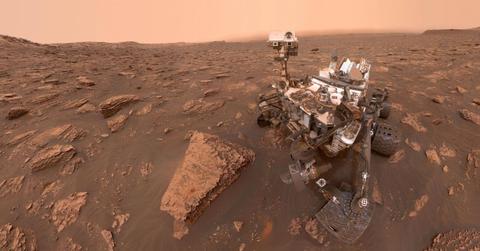Water on Mars? Rover Finds Ancient Riverbeds on Red Planet, Evidence Strongly Suggests

Data and pictures from NASA's Curiosity rover were central to the research.
A team of researchers examining the data collected by NASA's Curiosity Rover on Mars has discovered the ancient, eroded remnants of rivers in a number of craters on the red planet.
Knewz.com reported that scientists used a combination of images from the Curiosity rover, scans of sedimentary rock beneath the Gulf of Mexico, and computer simulations to reach this conclusion.
Numerical models used to simulate the erosion of Martian soil over millennia showed that common crater formations on Mars, called "bench-and-nose" landforms, are most likely remnants of ancient riverbeds.
Pennsylvania State University Geoscientist Benjamin Cardenas, lead author of the research, said in a statement: "We’re finding evidence that Mars was likely a planet of rivers. We see signs of this all over the planet."
"We have everything to learn about Mars by better understanding how these river deposits can be interpreted stratigraphically, thinking about rocks today as layers of sediment deposited over time... This analysis is not a snapshot, but a record of change. What we see on Mars today is the remnants of an active geologic history, not some landscape frozen in time," Cardenas added.
In an American Geophysical Union paper entitled Landforms Associated With the Aspect-Controlled Exhumation of Crater-Filling Alluvial Strata on Mars, Cardenas explained the exact method the team used to study the riverbeds of Mars.
- Benjamin Cardenas, Landforms Associated With the Aspect-Controlled Exhumation of Crater-Filling Alluvial Strata on MarsAncient river deposits exist across Mars and can be identified in satellite data by erosional landforms called fluvial ridges. Fluvial ridges take the shape of ancient river deposits, and are useful for understanding the history of water on Mars. However, the Curiosity rover at Gale crater, Mars, has observed river deposits that are not associated with fluvial ridges, but rather bench- and nose-like landforms that are not generally associated with ancient river deposits.
We modified a computer model that generates fluvial ridges from ancient river deposits by adding a preferred direction for scarp retreat, which may exist in craters on Mars because crater topography steers winds, and winds currently drive erosion on Mars. Our model generated benches and noses rather than fluvial ridges, demonstrating that these landforms may be used as indicators of ancient river deposits in craters on Mars, similar to fluvial ridges.
However, what is perhaps even more exciting about this discovery is the implications that it bears.
Rivers, or the presence of water, have always been associated with life. On Earth, rivers are responsible for nutrient and chemical cycles that are necessary for life to thrive. Cardenas said in his statement that everything points towards "these rivers behaving similarly on Mars."
"This suggests that there could be undiscovered river deposits elsewhere on the planet, and that an even larger section of the Martian sedimentary record could have been built by rivers during a habitable period of Mars history," he said.
Never miss a story — sign up for the Front Page Detectives newsletter. Be on the scene the moment news breaks.
Having discovered the signs of this network of rivers in ancient Mars, scientists are entertaining the possibility that the red planet might have been a habitable place at some point in time.
"Our research indicates that Mars could have had far more rivers than previously believed, which certainly paints a more optimistic view of ancient life on Mars... It offers a vision of Mars where most of the planet once had the right conditions for life," Cardenas said in this regard.
Become a Front Page Detective
Sign up to receive breaking
Front Page Detectives
news and exclusive investigations.
